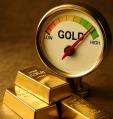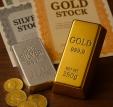Gold Ends Sharply Higher As U.S. GDP Growth Slows
New York (Jan 30) Gold futures surged to end higher on Friday, rebounding from a sharp decline yesterday, with investors seeking the safe haven of the precious metal after some disappointing economic activity data from the U.S. with gross domestic product growth for the fourth quarter rising less than expected.
Yesterday, gold slumped over 2.4 percent to record its its biggest one-day decline in 13 months.
Economic activity in the U.S. continued to increase in the fourth quarter, although the pace of growth slowed more than economists expected. Trade was a big drag in the fourth quarter, reflecting a notable deceleration in export growth and an uptick in imports.
Policy makers have vowed to remain patient before tightening the interest rates, but have demurred from offering a more specific timeline.
Yesterday, Fed Chair Janet Yellen told lawmakers that she has some concerns about the economic situation in Europe but feels the U.S. economy is "strong," according to a Bloomberg report quoting Sen. Tim Kaine of Virginia and Sen. Joe Manchin from West Virginia. The Fed left out any specific mention of problems in Europe from its monetary policy announcement on Wednesday.
Gold for February delivery, the most actively traded contract, jumped $23.90 or 1.9 percent, to settle at $1,278.50 an ounce on the Comex division of the New York Mercantile Exchange on Friday.
Gold for February delivery scaled an intraday high of $1,278.50 and a low of $1,257.50 an ounce.
On Wednesday, gold ended lower at $1,254.60 an ounce, down $31.30 or 2.4 percent, after some upbeat economic data showed first-time claims for unemployment benefits in the U.S. declined more than expected while eurozone economic confidence rose to a six-month high.
Holdings of SPDR Gold Trust, the world's largest gold-backed exchange-traded fund, increased to 758.37 tons on Friday, from its previous close of 752.70 tons.
The dollar index, which tracks the U.S. unit against six major currencies, traded at 94.85 on Friday, up from its previous close of 94.68 late Thursday in North American trade. The dollar scaled a high of 94.91 intraday and a low of 94.43.
The euro trended lower against the dollar at $1.1294 on Friday, as compared to its previous close of $1.1320 late Thursday in North American trade. The euro scaled a high of $1.1366 intraday and a low of $1.1281.
In economic news, a Commerce Department report showed U.S. gross domestic product to have climbed 2.6 percent in the fourth quarter following the 5.0 percent jump seen in the third quarter. Economists anticipated GDP to increase by a somewhat more substantial 3.2 percent during the quarter.
Chicago-area business activity unexpectedly grew at a faster pace in January, a report from MNI Indicators said Friday. The Chicago business barometer rebounding following two consecutive monthly declines to 59.4 in January from a revised 58.8 in December. Economists expected the index to drop to a reading of 57.7.
A University of Michigan report showed a modest downward revision to its reading on U.S. consumer sentiment for January, with the index remaining at an eleven-year high. The index for January was downwardly revised to 98.1 from the mid-month reading of 98.2, but well above the final December reading of 93.6 and is at its best level since reaching 103.8 in January 2004.
The survey's gauge of consumer expectations in January was downwardly revised to 91.0 from 91.6 but remained well above the 86.4 recorded for December. Meanwhile, the reading on current economic conditions in January was upwardly revised to 109.3 from 108.3 and is well above 104.8 in the previous month.
Elsewhere, the euro area jobless rate fell unexpectedly to the lowest level since August 2012, yet remains elevated. The unemployment rate came in at a double-digit 11.4 percent in December, slightly down from 11.5 percent in November. It was expected to remain unchanged at 11.5 percent in December.
Meanwhile, eurozone consumer prices declined for the second straight month in January due largely to lower energy prices, posting the biggest annual fall since 2009. The harmonized index of consumer prices in the 19-nation currency bloc fell 0.6 percent year-on-year in January, with a similar rate of decline last seen only in July 2009. Final data is due on February 24. This was the second consecutive fall in prices and exceeded the 0.5 percent drop forecast by economists. Prices were down 0.2 percent in December, which was the first decline since October 2009.
The leading index for eurozone, which measures future economic activity, increased for the second straight month in December, a Conference Board report showed. The Conference Board's leading economic index rose 0.2 percent in December, the same increase seen in the previous month. In October, the index dropped 0.1 percent.
Germany's retail sales rose at a slower than expected rate in December, preliminary data from Destatis showed Friday. Sales grew a calendar and seasonally-adjusted 0.1 percent month-on-month in December following the 0.5 percent gain in November. Economists had expected sales to increase 0.3 percent.
French consumer spending grew at its fastest pace in nearly three years during December, led by a marked rebound in energy consumption, figures from the statistical office INSEE revealed Friday. Household consumption rose 1.5 percent from November, when it grew 0.2 percent, revised down from 0.4 percent. Economists had forecast only 0.5 percent growth for the month. The latest consumption growth was the biggest since February 2012, when it was 2.4 percent.
An index measuring consumer confidence in the United Kingdom increased more than expected. The latest survey from polling company GfK showed consumer confidence index at 1 in January, turning positive unexpectedly as economists forecast the index to come in at -2. This follows the nine-month low score of -4 in December.
China's fiscal revenue grew at the slowest pace since 1991, data from the Ministry of Finance showed Friday. Revenue increased 8.6 percent to CNY 14.03 trillion in 2014 compared to a 10.2 percent rise in 2013. Land sales revenue gained only 3.2 percent due to the slowdown in property market activity. At the same time, fiscal expenditure rose at a slower pace of 8.2 percent to CNY 15.16 trillion. As a result, the fiscal deficit came in at CNY 1.13 trillion in 2014.
Source: RTTnews










